 W
WBioretention is the process in which contaminants and sedimentation are removed from stormwater runoff. Stormwater is collected into the treatment area which consists of a grass buffer strip, sand bed, ponding area, organic layer or mulch layer, planting soil, and plants. Runoff passes first over or through a sand bed, which slows the runoff's velocity, distributes it evenly along the length of the ponding area, which consists of a surface organic layer and/or groundcover and the underlying planting soil. The ponding area is graded, its center depressed. Water is ponded to a depth of 15 cm (5.9 in) and gradually infiltrates the bioretention area or is evapotranspired. The bioretention area is graded to divert excess runoff away from itself. Stored water in the bioretention area planting soil exfiltrates over a period of days into the underlying soils.
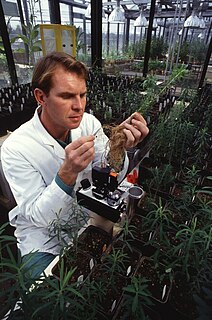 W
WRhizofiltration is a form of phytoremediation that involves filtering contaminated groundwater, surface water and wastewater through a mass of roots to remove toxic substances or excess nutrients.
 W
WAmbrosia artemisiifolia, with the common names common ragweed, annual ragweed, and low ragweed, is a species of the genus Ambrosia native to regions of the Americas.
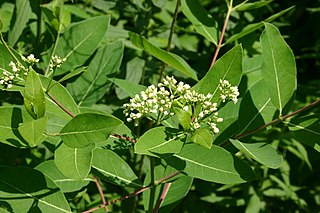 W
WApocynum cannabinum is a perennial herbaceous plant that grows throughout much of North America—in the southern half of Canada and throughout the United States. It is a poisonous plant: Apocynum means "poisonous to dogs". All parts of the plant are poisonous and can cause cardiac arrest if ingested. However, some Lepidoptera feed on this plant, such as two hummingbird moths. The specific epithet cannabinum and the common names hemp dogbane and Indian hemp refer to its similarity to Cannabis as a fiber plant, rather than as a source of a psychoactive drug.
 W
WAn arborloo is a simple type of composting toilet in which feces are collected in a shallow pit and a fruit tree is later planted in the fertile soil of the full pit. Arborloos have: a pit like a pit latrine but less deep; a concrete, ferrocement or other strong floor; a superstructure to provide privacy; and possibly a ring beam to protect the pit from collapsing. The pit should remain well above the water table in the soil, so as to not contaminate groundwater.
 W
WBarley, a member of the grass family, is a major cereal grain grown in temperate climates globally. It was one of the first cultivated grains, particularly in Eurasia as early as 10,000 years ago. Barley has been used as animal fodder, as a source of fermentable material for beer and certain distilled beverages, and as a component of various health foods. It is used in soups and stews, and in barley bread of various cultures. Barley grains are commonly made into malt in a traditional and ancient method of preparation.
 W
WBrassica juncea, commonly brown mustard, Chinese mustard, Indian mustard, leaf mustard, Oriental mustard and vegetable mustard, is a species of mustard plant.
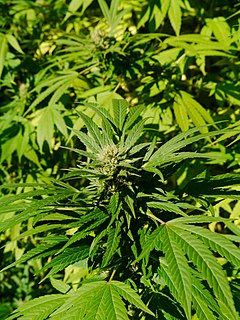 W
WCannabis sativa is an annual herbaceous flowering plant indigenous to Eastern Asia but now of cosmopolitan distribution due to widespread cultivation. It has been cultivated throughout recorded history, used as a source of industrial fiber, seed oil, food, recreation, religious and spiritual moods and medicine. Each part of the plant is harvested differently, depending on the purpose of its use. The species was first classified by Carl Linnaeus in 1753. The word "sativa" means things that are cultivated.
 W
WCarex nebrascensis is a species of sedge known as Nebraska sedge.
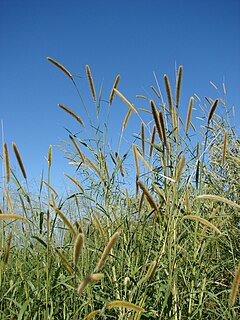 W
WCenchrus purpureus, synonym Pennisetum purpureum, also known as Napier grass, elephant grass or Uganda grass, is a species of perennial tropical grass native to the African grasslands. It has low water and nutrient requirements, and therefore can make use of otherwise uncultivated lands. Historically, this wild species has been used primarily for grazing, recently, however, it has been used as part of a push–pull agricultural pest management strategy. Napier grasses improve soil fertility, and protect arid land from soil erosion. It is also utilized for firebreaks, windbreaks, in paper pulp production and most recently to produce bio-oil, biogas and charcoal.
 W
WFestuca arundinacea (syn., Schedonorus arundinaceus and Lolium arundinaceum) is a species of grass commonly known as tall fescue. It is a cool-season perennial C3 species of bunchgrass native to Europe. It is an important forage grass throughout Europe, and many cultivars have been used in agriculture. It is also an ornamental grass in gardens, and a phytoremediation plant.
 W
WHelianthus annuus, the common sunflower, is a large annual forb of the genus Helianthus grown as a crop for its edible oil and edible fruits. This sunflower species is also used as wild bird food, as livestock forage, in some industrial applications, and as an ornamental in domestic gardens. The plant was first domesticated in the Americas. Wild Helianthus annuus is a widely branched annual plant with many flower heads. The domestic sunflower, however, often possesses only a single large inflorescence atop an unbranched stem. The name sunflower may derive from the flower's head's shape, which resembles the sun.
 W
WHydrilla (waterthyme) is a genus of aquatic plant, usually treated as containing just one species, Hydrilla verticillata, though some botanists divide it into several species. It is native to the cool and warm waters of the Old World in Asia, Africa and Australia, with a sparse, scattered distribution; in Australia from Northern Territory, Queensland, and New South Wales.
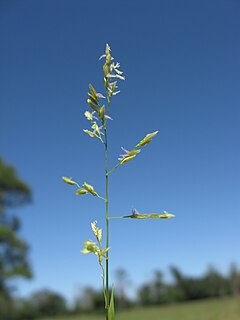 W
WLeersia hexandra is a species of grass known by the common names southern cutgrass, clubhead cutgrass, and swamp rice grass. It has a pantropical distribution. It is also an introduced species in many regions, sometimes becoming invasive, and it is an agricultural weed of various crops, especially rice. It is also cultivated as a forage for livestock.
 W
WLemnoideae is a subfamily of flowering aquatic plants, known as duckweeds, water lentils, or water lenses. They float on or just beneath the surface of still or slow-moving bodies of fresh water and wetlands. Also known as "bayroot", they arose from within the arum or aroid family (Araceae), so often are classified as the subfamily Lemnoideae within the family Araceae. Other classifications, particularly those created prior to the end of the twentieth century, place them as a separate family, Lemnaceae.
 W
WLupinus microcarpus, the wide-bannered lupine or chick lupine, is a species of lupine native to western North America from southwestern British Columbia south through Oregon and California, including the Mojave Desert, and into Baja California. There is also a disjunct population in South America, with locations in central Chile and western Argentina.
 W
WMelilotus officinalis, known as yellow sweet clover, yellow melilot, ribbed melilot and common melilot, is a species of legume native to Eurasia and introduced in North America, Africa, and Australia.
 W
WMoringa oleifera is a fast-growing, drought-resistant tree of the family Moringaceae, native to the Indian subcontinent. Common names include moringa, drumstick tree, horseradish tree, and ben oil tree or benzolive tree.
 W
WPanicum virgatum, commonly known as switchgrass, is a perennial warm season bunchgrass native to North America, where it occurs naturally from 55°N latitude in Canada southwards into the United States and Mexico. Switchgrass is one of the dominant species of the central North American tallgrass prairie and can be found in remnant prairies, in native grass pastures, and naturalized along roadsides. It is used primarily for soil conservation, forage production, game cover, as an ornamental grass, in phytoremediation projects, fiber, electricity, heat production, for biosequestration of atmospheric carbon dioxide, and more recently as a biomass crop for ethanol and butanol.
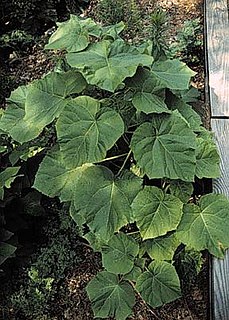 W
WPaulownia is a genus of seven to 17 species of flowering plants in the family Paulowniaceae, in the order Lamiales. They are present in much of China, south to northern Laos and Vietnam and are long cultivated elsewhere in eastern Asia, notably in Japan and Korea where they are native.
 W
WPhalaris arundinacea, or reed canary grass, is a tall, perennial bunchgrass that commonly forms extensive single-species stands along the margins of lakes and streams and in wet open areas, with a wide distribution in Europe, Asia, northern Africa and North America. Other common names for the plant include gardener's-garters in English, alpiste roseau in French, rohrglanzgras in German, kusa-yoshi in Japanese, caniço-malhado in Portuguese, and hierba cinta and pasto cinto in Spanish.
 W
WPhragmites is a genus of four species of large perennial reed grasses found in wetlands throughout temperate and tropical regions of the world.
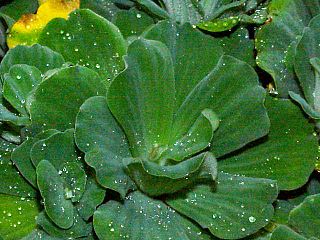 W
WPistia is a genus of aquatic plant in the arum family, Araceae. The single species it comprises, Pistia stratiotes, is often called water cabbage, water lettuce, Nile cabbage, or shellflower. Its native distribution is uncertain, but probably pantropical; it was first discovered from the Nile near Lake Victoria in Africa. It is now present, either naturally or through human introduction, in nearly all tropical and subtropical fresh waterways and considered an invasive species as well as a mosquito breeding habitat. The genus name is derived from the Greek word πιστός (pistos), meaning "water," and refers to the aquatic nature of the plants.
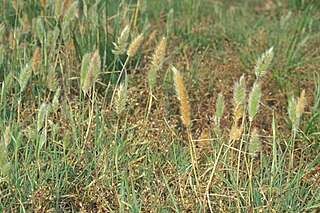 W
WPolypogon is a nearly cosmopolitan genus of plants in the grass family, commonly known beard grass or rabbitsfoot grass.
 W
WPteris vittata, commonly known variously as the Chinese brake, Chinese ladder brake, or simply ladder brake, is a fern species in the Pteridoideae subfamily of the Pteridaceae. It is indigenous to Asia, southern Europe, tropical Africa and Australia. The type specimen was collected in China by Pehr Osbeck.
 W
WRestoration ecology is the scientific study supporting the practice of ecological restoration, which is the practice of renewing and restoring degraded, damaged, or destroyed ecosystems and habitats in the environment by active human intervention and action. Effective restoration requires an explicit goal or policy, preferably an unambiguous one that is articulated, accepted, and codified. Restoration goals reflect societal choices from among competing policy priorities, but extracting such goals is typically contentious and politically challenging.
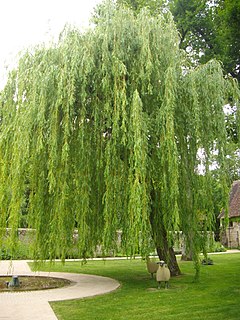 W
WSalix babylonica is a species of willow native to dry areas of northern China, but cultivated for millennia elsewhere in Asia, being traded along the Silk Road to southwest Asia and Europe.
 W
WSalix viminalis, the basket willow, common osier or osier, is a species of willow native to Europe, Western Asia, and the Himalayas.
 W
WSalsola soda, more commonly known in English as opposite-leaved saltwort, oppositeleaf Russian thistle, or barilla plant, is a small, annual, succulent shrub that is native to the Mediterranean Basin. It is a halophyte that typically grows in coastal regions and can be irrigated with salt water.
 W
WA sugar beet is a plant whose root contains a high concentration of sucrose and which is grown commercially for sugar production. In plant breeding it is known as the Altissima cultivar group of the common beet. Together with other beet cultivars, such as beetroot and chard, it belongs to the subspecies Beta vulgaris subsp. vulgaris. Its closest wild relative is the sea beet.
 W
WThlaspi caerulescens, the Alpine Penny-cress or alpine pennygrass, is a flowering plant in the family Brassicaceae. It is found in Scandinavia and Europe.
 W
WTradescantia pallida is a species of spiderwort similar to T. fluminensis and T. zebrina. Other common names include purple secretia, purple-heart, and purple queen. It is native to the Gulf Coast region of eastern Mexico. Edward Palmer collected the type specimen near Ciudad Victoria, Tamaulipas in 1907.
 W
WVicia faba, also known in the culinary sense as the broad bean, fava bean, or faba bean, is a species of flowering plant in the pea and bean family Fabaceae. It is of uncertain origin and widely cultivated as a crop for human consumption. It is also used as a cover crop. Varieties with smaller, harder seeds that are fed to horses or other animals are called field bean, tic bean or tick bean. Horse bean, Vicia faba var. equina Pers., is a variety recognized as an accepted name.
 W
WWolffia arrhiza is a species of flowering plant known by the common names spotless watermeal and rootless duckweed, belonging to the Araceae, a family rich in water-loving species, such as Arum and Pistia. It is the smallest vascular plant on Earth. It is native to Europe, Africa, and parts of Asia, and it is present in other parts of the world as a naturalized species. It is an aquatic plant which grows in quiet water bodies such as ponds. The green part of the plant, the frond, is a sphere measuring about 1 mm wide, but with a flat top that floats at the water's surface. It has a few parallel rows of stomata. There is no root. The plant produces a minute flower fully equipped with one stamen and one pistil. It often multiplies by vegetative reproduction, however, with the rounded part budding off into a new individual. In cooler conditions the plant becomes dormant and sinks to the bed of the water body to overwinter as a turion. The plant is a mixotroph which can produce its own energy by photosynthesis or absorb it from the environment in the form of dissolved carbon.